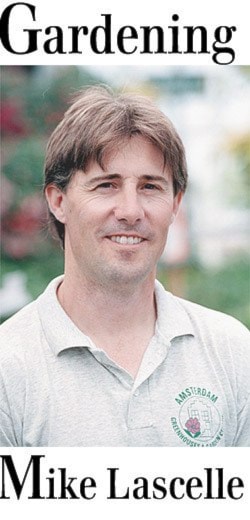It took a while, but long-time Maple Ridge resident Jon Harris has finally joined the ranks of such venerable agronomists as the Mesolithic Scots (circa 700 BC), first dynasty Chinese and Pliny’s Romans in becoming a bona fide hazelnut farmer.
The former district councillor and notary public began this exercise in growing local back in the fall of 2000 when he planted 265 trees over 2.5 acres, using a mix of three cultivars (‘Barcelona’, ‘Ennis’, ‘Butler’) in order to cover the necessary cross-pollination.
Hazelnuts are wind pollinated (although bees are also attracted to the pollen), with the long male catkins releasing their dusty yellow pollen from late January into February – fertilizing the minuscule reddish-purple female flowers that are held closely to the stems.
Hazelnuts (Corylus avellana) get their common name from the Anglo-Saxon word haesel which means headdress or bonnet, an apt description of the nut’s fringed husk.
Its other namesake, Filbert, is thought to be a reference to Saint Philibert’s Day (Aug. 22), a date which also coincides with the beginning of the European hazelnut harvest.
Whatever you choose to call them, to Jon they are a labour of love which involves propagating new plants, regular pruning (particularly sucker removal) to keep his trees to a single stem, fertilizing with compost, and flailing the turf about five times a year.
Like any farmer growing a specialized crop, Jon has experienced a few setbacks along the way – in particular bears and eastern filbert blight.
The bruins are a relatively new occurrence, as Jon doesn’t recall any when he first bought the property back in 1958 but speculates that the recent boon in blueberries has drawn them closer to town.
Last fall, upwards of five bears at a time ate enough hazelnuts to push his modest profits below the amount needed to claim farm tax status, with the cubs climbing the trees and causing a lot of damage.
This year’s yield was about 800 lbs including the losses to the bears, although the year before it was 1,200 lbs and it should get better as the orchard ages (mature trees produce about 18 lbs).
Harvesting is a relatively simple process, as a tarp (with a slot to accommodate the stem) is placed below each tree to catch the nuts as it is shaken – this usually takes place from the second week in September, for a month, through to October – as different cultivars ripen at different times.
Eastern filbert blight arrived after Jon had planted, with the initial infection occurring in Abbotsford in 2001 and having now spread throughout much of the Fraser Valley. Diligent monitoring and pruning has kept this problem in check but Jon plans to replant with newer blight resistant cultivars (‘Jefferson’, ‘Sacajawea’) that have been recently introduced by the University of Oregon.
Another of these introductions, ‘Yamhill’, is more compact than the others and will probably be your best choice for residential gardens, although these cultivars are just coming onto the retail market and may be hard to locate. In any case, you can find more information on this disease concern and a comprehensive listing of resistant cultivars by visiting mikesgardenguide.wordpress.com and typing “eastern filbert blight” into the search engine.
Challenges aside, Jon takes well-deserved pride in his recent harvest – after all, there aren’t many people who would bother starting an orchard from scratch.
And if all goes well, he will be offering his delicious hazelnuts through local stores and we can enjoy yet another crop that is proudly grown in Maple Ridge.
Mike Lascelle is a local nursery manager and gardening author. (hebe_acer@hotmail.com.)
